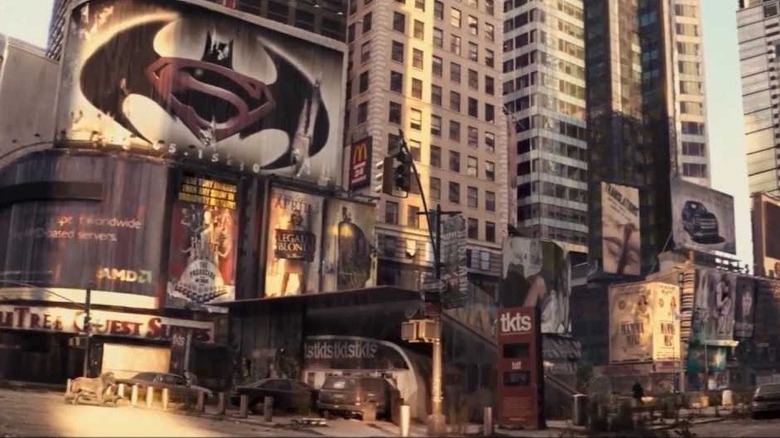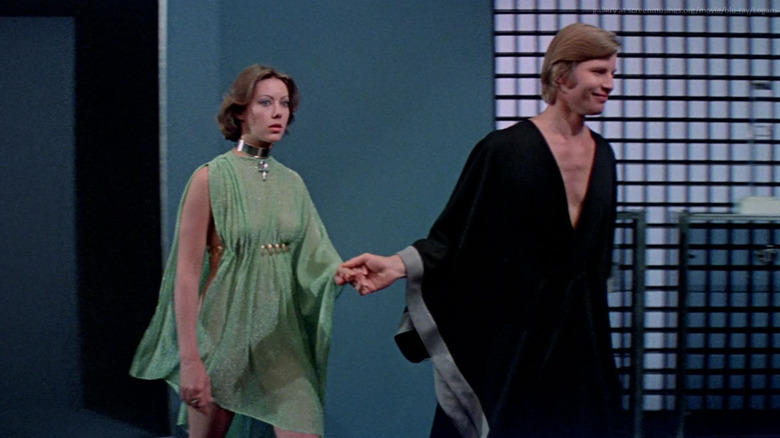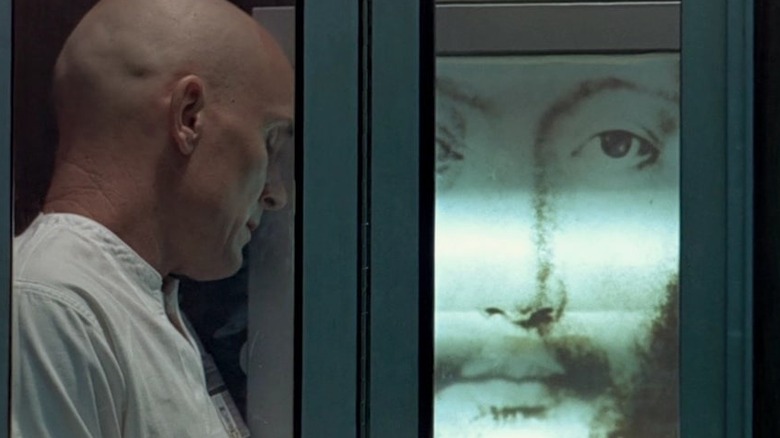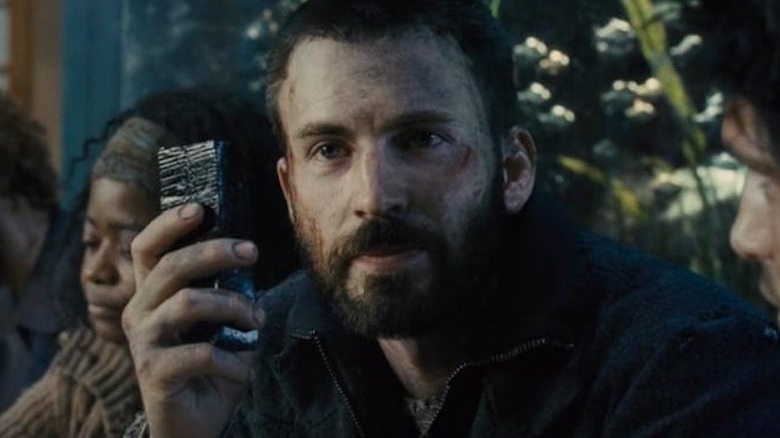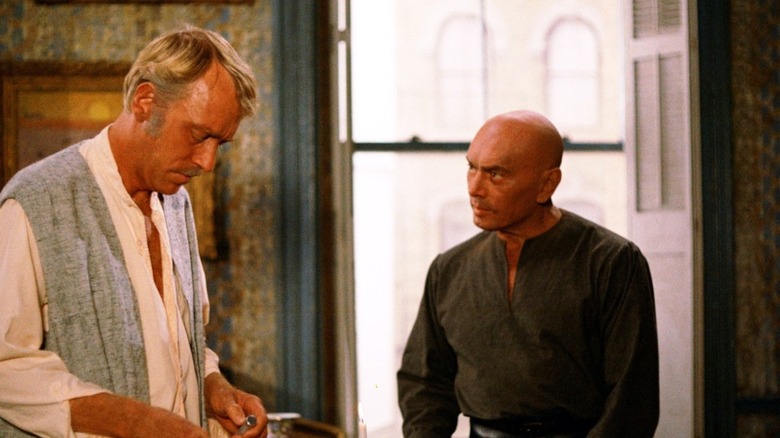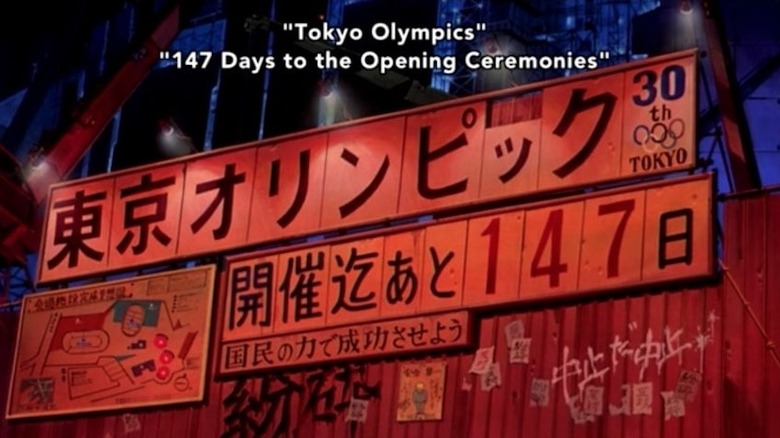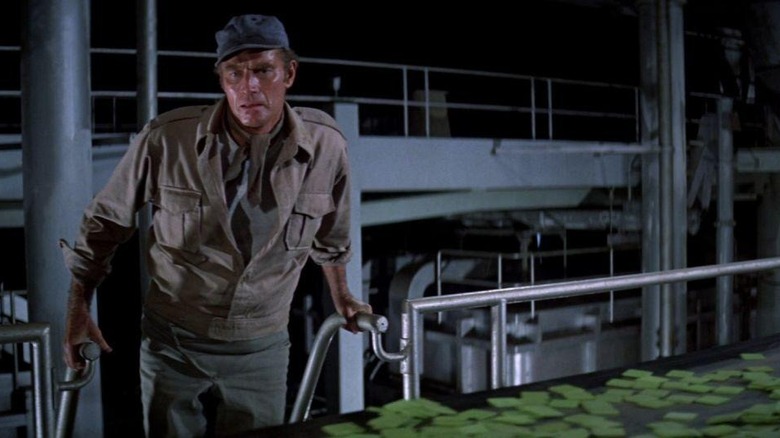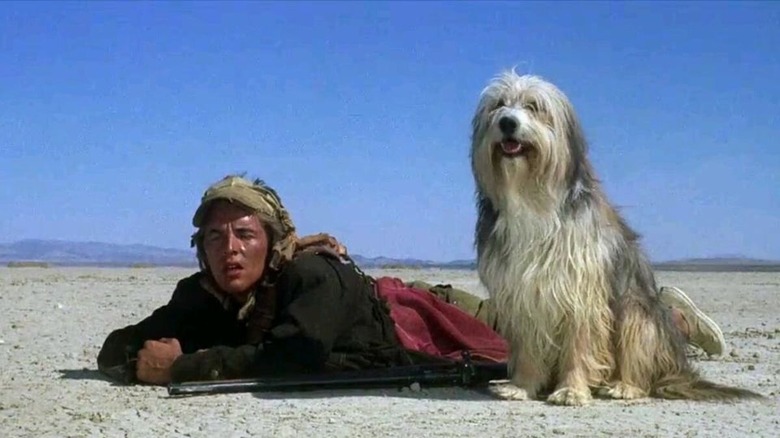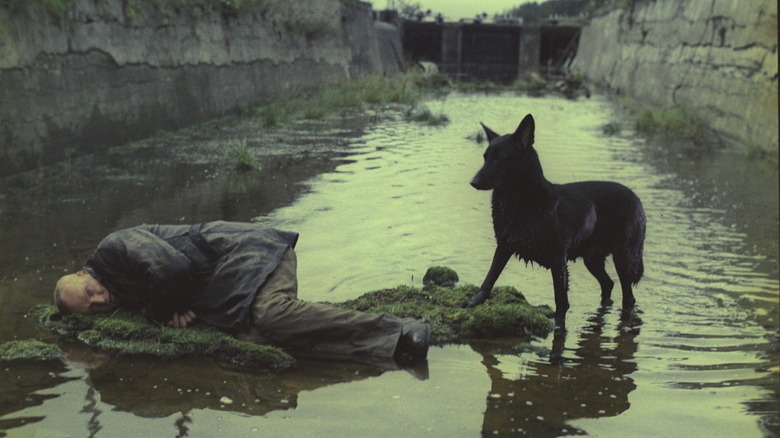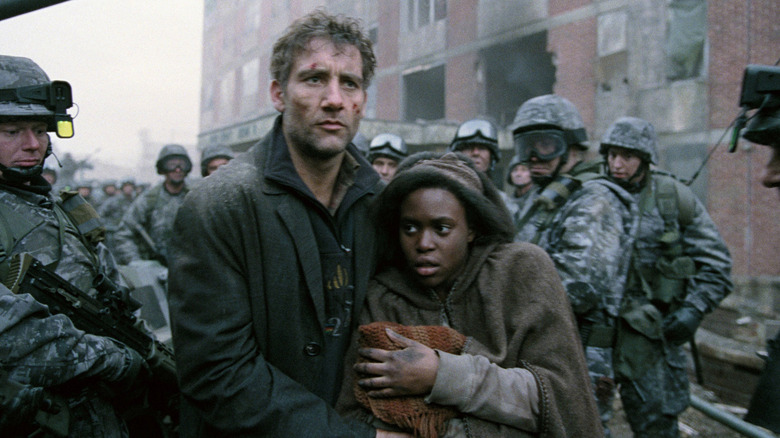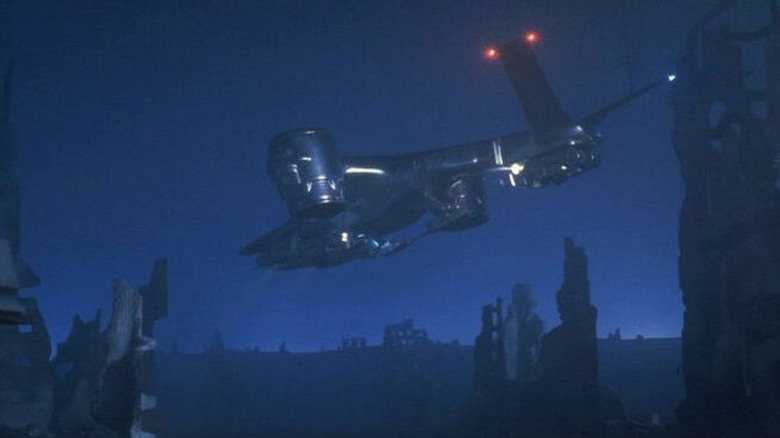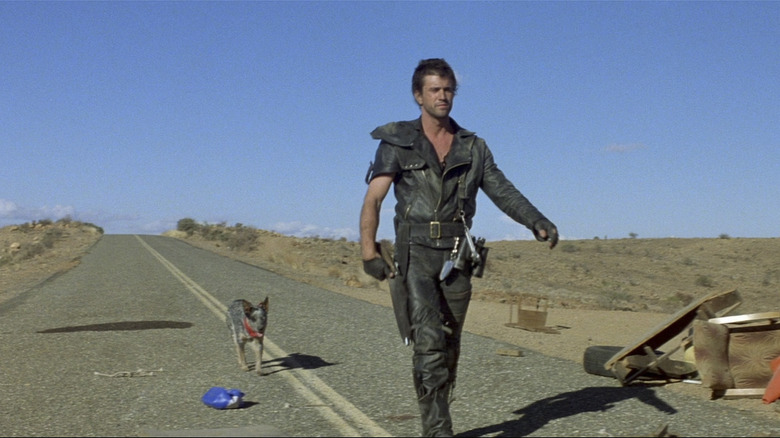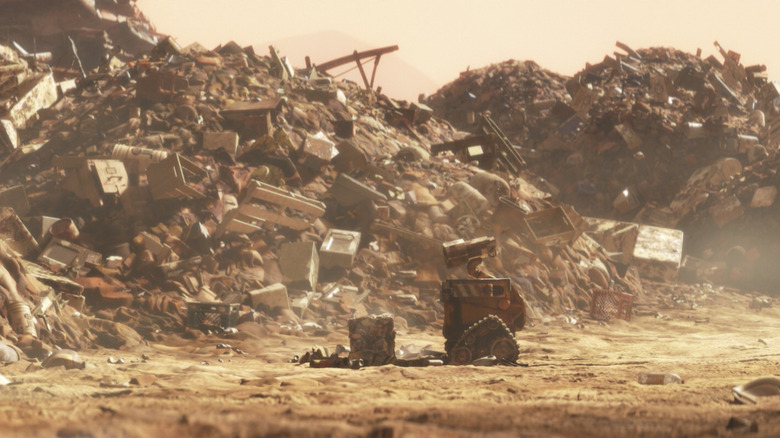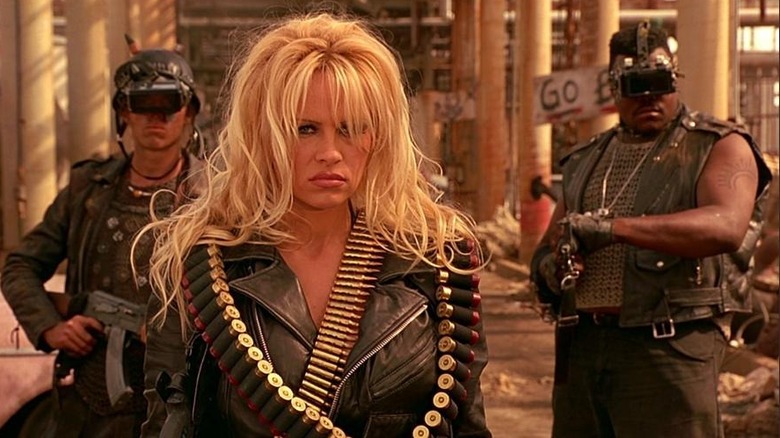Post-Apocalyptic Movies That Predicted The Future
There's a common hypothesis, whispered amongst starry-eyed directors and cinephiles alike, that films are collective dreams. And just like dreams, some films dip into the realm of prophecy, especially when they are explicitly concerned with looking forward into possible futures where humanity and the Earth are in dire straits. Post-apocalyptic films have a tendency to tap into primal and emerging fears regarding the extinction of our species, as well as the creeping guilt that we've sullied the planet we call home. And while some predictions are more dread-inducing and on-the-nose than others, the thrill of engaging with post-apocalyptic content is the hope that with knowledge comes the power to sidestep our potential downfall.
But, alas, movies don't always prevent us from sowing the seeds of our own destruction. Below you'll find a collection of cinematic post-apocalyptic scenarios that came true, in one form or another. There's depressing environmental devastation and malignant happy accidents, but all told, it probably won't hurt to pay close attention to these eerie cinematic soothsayers.
Beware: some spoilers ahead.
I Am Legend hinted at a DC superhero face off
Being the last person on Earth is an undoubtedly hellish apocalyptic scenario. You can only have so many intelligent conversations with storefront mannequins and your trusty German shepherd. 2007's "I Am Legend" marks the third, and most recent, big screen adaptation of Richard Matheson's sci-fi horror novel of the same name. While 1964's "The Last Man on Earth" and 1971's "The Omega Man" have their charms, nothing can compare to the jaw-dropping spectacle of seeing an overgrown, deserted vision of modern-day Times Square.
Our hero, a US Army virologist named Robert Neville (Will Smith), is supposedly the last man standing after a violent virus has transformed humanity into nocturnal mutants. While he works on a cure, the good doctor wanders the deserted streets of New York City scavenging for resources. It's during one of his daytime expeditions that eagle-eyed viewers may have caught a whiff of prophecy: a billboard with Batman and Superman's respective logos superimposed over each other. While the billboard's proposed release date, "5-15-10," is a bit off, the two titans of DC did duke it out on the big screen. In 2013, Zack Snyder's "Batman v Superman: Dawn of Justice" was announced at San Diego Comic Con, six years after "I Am Legend" hit theaters. Per a 2014 Collider interview with "I Am Legend" director Francis Lawrence, the billboard was an in-joke at the expense of the film's writer-producer, Akiva Goldsman, whose attempts to get a Batman and Superman movie off the ground never materialized.
Logan's Run anticipated dating apps
A staple of mid-1970s science fiction and a chilling vision of what the future may hold, "Logan's Run" is one of the most striking (and colorful) apocalyptic visions ever to grace the silver screen. Based on William F. Nolan and George Clayton Johnson's novel of the same name, the film takes place in the year 2274, long after the vast majority of humanity has perished. (In the film our demise is left ambiguous whereas in the book, the young systematically overthrow the old). What's left of humanity lives in a highly artificial sealed city. There, everyone who reaches the age of 30 is ritualistically euthanized to maintain the balance of the society's population and the available resources.
Given that terrifying expiry date, many citizens in "Logan's Run" dabble heavily in hedonism, which naturally includes an especially relaxed attitude towards casual hook-ups. In one scene early in the film, Logan (Michael York) waltzes across his modular apartment to his floor-to-ceiling television known as "The Circuit." Using the remote, Logan tunes in and out (or "swipes," if you will) through an assortment of prospective partners based on their appearance. He turns the dial, and a strapping, muscle-bound lad appears. Logan shakes his head in polite refusal, turns a knob on his remote, and the man vanishes. Next up is a beautiful woman (Jenny Agutter) who seems to strike Logan's fancy. She materializes right there in his living room, and the two get to chatting. Let's hope dating apps are the only thing "Logan's Run" predicts.
Amazon's ZenBooths look suspiciously like THX 1138's Unichapel
If we ever needed hard proof that we're careening towards the end times, it's the fact that the confession booths from "THX 1138" apparently exist now. George Lucas' 1971 feature film debut envisions a future in which humanity has been driven underground. The surface, we're told, is inhospitable: a toxic wasteland that will surely kill anyone stupid enough to attempt an escape. Our titular protagonist THX 1138 (Robert Duvall) is overwhelmed by a variety of stressors, least of all his growing suspicion that his roommate (Maggie McOrnie) is weaning him off his emotion-suppressing drugs. Luckily THX can find relief in any of the many, many "confession booths," where an AI deity known as "OMM 0000" offers soothing assurance and reminds you to "work hard, increase production, prevent accidents, and be happy."
Enter Amazon in 2021, who thought it would be a very chill and not dystopian thing to introduce meditation booths in the middle of its warehouse to assuage the frayed nerves of its overworked, underpaid workers. Is it concerning that they're shaped like a coffin? Yep. Is it wildly patronizing to think deep breathing is a salve for allegedly debilitating working conditions? Sure is. Nothing a pamphlet, a small fan, and some company-approved guided meditation won't fix. Living in the future stinks.
Snowpiercer was onto bugs as a climate crisis protein source
Don't pinch your nose just yet. There may come a time where a jet-black brick of cockroach jelly is a regular, acceptable protein source. In Bong Joon-Ho's 2013 film "Snowpiercer," a failed attempt to reverse the effects of global warming has kicked off a full-blown ice age. What's left of the human race is relegated to a massive, globe-circling train called the Snowpiercer which is segregated by economic class. In the back cabins, the poorest denizens consume rationed "protein bars," which our characters later learn are made up of pulverized cockroaches.
Insects are included in the diets of many cultures, which makes sense because they're a great source of protein. Indeed, if you think of entomophagy as a taboo, according to National Geographic, you might be in the minority. Eating insects has a variety of advantages, from food security to pest control. But push may have to come to shove before the West starts gobbling grubs, and by "shove" we mean the climate crisis. Insects consume 10 times less plant material than traditional livestock, and take up a fraction of the space and water usage required for cattle. They also breed a heck of a lot faster. All told, there's a growing push in the West towards eating insects as a response to the climate crisis. Heck, cricket protein powder is popping up left and right. So wipe that grimace off your face, Chris Evans, we've got a planet to save.
The Ultimate Warrior understood the value of seeds
A global pandemic has devastated the Earth's population. In New York City, the lucky have taken up residence in a fortified enclave, where they attempt to find a sense of normalcy under the constant barrage of attacks from roving gangs of pillagers. The leader of the compound is Baron (Max von Sydow), who along with the group's resident scientist Cal (Richard Kelton) has developed a way to germinate plague-resistant seeds and grow vegetables within once-barren soil. It's a miracle, and a huge target on their backs. But the Baron hopes their recruitment of a deadly gun for hire named Carson (Yul Brynner) will protect them from the lawless outside threat.
Directed by Robert Clouse (of "Enter the Dragon" fame), "The Ultimate Warrior" rightly guessed all the way back in 1975 that seeds would be a wildly important piece of the puzzle in the face of a global environmental crisis. One of the most striking modern examples of seed banks, fortified vaults created with the sole purpose of securing and preserving seeds, is the Svalbard Global Seed Vault, located on a remote Arctic archipelago. In existence in a smaller scope since the mid-80s, the Seed Vault kicked off in earnest in 2008. As of June 2021, the Seed Vault safeguards 1,081,026 distinct crop samples. As the Vault's website cryptically states, "There may be a role for the Seed Vault in the event of global catastrophe." Cool.
Akira correctly guessed that Tokyo would get the 2020 Olympics
Directed by Katsuhiro Otomo (who also authored the original manga of the same name), 1987's "Akira" takes place in the far-flung future of 2019. A devastating world war has flattened cities and led to the emergence of violent protests, corruption, and gang violence, not to mention mutated psychic teenagers with extra-sensory powers. Fittingly, the film itself has a keen apprehension of what the real 2019-2020 held for us.
One of the most weirdly prescient moments occurs soon after the opening bike chase. As most of the characters are arrested (and one, somewhat ominously, is shepherded to a hospital), we're greeted by an enormous sign in front of a construction site teasing that Neo-Tokyo will host the 2020 Olympic games. For those who may have forgotten in the hustle and bustle of the global pandemic, real-life Tokyo was, in fact, selected to host the 2020 Olympics until they were postponed due to COVID-19. Turns out the graffiti under the sign in "Akira" — a resigned bid to "Just cancel it" – was also right on the money.
Soylent Green and the rise of one-and-done meal substitutes
Based on the disturbingly-named 1966 sci-fi novel "Make Room! Make Room!," 1973's "Soylent Green" is set in a harrowing (and completely plausible) future where a climate crisis is killing the oceans and causing insufferable humidity, in turn leading to global pollution, poverty, and overpopulation. The film takes place in 2022, so enjoy yourselves while you can. In the film, New York City relies on Soylent Industries to produce sustainable meal substitutes for its populace: colored wafers, of which the green variety is the most sought-after. While it's ostensibly made out of ocean plankton, our intrepid hero (Charlton Heston) learns the dark truth about Soylent Green — namely, that it's made out of euthanized human corpses.
Thankfully, we're not eating each other just yet. But we are dumbing down our meals into monotone muck. Meal replacements for work-focused tech bros abound, some more dystopian and on-the-nose than others. It also turns out that Soylent Industries was onto something with the whole "eating sea stuff" thing, albeit not with humans eating plankton, but cows eating seaweed.
A Boy and His Dog anticipated greater communication with our furry friends
Based on Harlan Ellison's novella of the same name, 1975's "A Boy and His Dog" takes place in the post-nuclear wasteland of 2024. Our 18-year-old hero Vic (Don Johnson) wanders the irradiated southwestern United States in search of food and babes. He's accompanied by his wildly intelligent (and surprisingly well-read) telepathic dog, Blood (voiced by Tim McIntire).
Now, sure, man's best friend isn't telepathic just yet. But with the push of a button, dogs are building their lexicon. If you've been on Instagram or TikTok lately, you may have encountered the growing number of "talking" canines, who use a collection of buttons programmed with pre-recorded words (also known as an augmentative and alternative communication device) to voice their every demand, whim, and passing thought. Whether social media superstar Bunny the talking dog will say things like "breeding is an ugly thing" or "war is hell" remains to be seen. But maybe it's just a matter of buying more buttons. Also, is anyone else creeped out by the fact that Blood is a sheep dog and Bunny is a sheepadoodle? Just us? Okay.
Stalker predicted nuclear site tourism
Set in a forsaken crumbling future, the protagonist of Andrei Tarkovsky's 1979 masterpiece "Stalker" works in an unnamed location where he leads people through the "Zone," a location sealed off by the government that is seemingly exempt from the accepted laws of physics. Vestiges of past extraterrestrial activity haunt its ruins, and a mysterious place within The Zone, known only as the "Room," is said to grant wishes.
While "Stalker" came out long before the destruction visited by the Chernobyl disaster, its finger is certainly on the pulse not only of nuclear devastation, but the odd tourism industry that followed. Indeed, Tarkovsky's film is hard proof of what many tourists hope to glimpse in their pilgrimages to deserted nuclear zones: the strange beauty of crumbling concrete, waterlogged tunnels, and abandoned cities. Also known as "atomic tourism," the phenomenon (via the New York Times) sees visitors to radiation-ravaged sites such as the Chernobyl Exclusion Zone and the deserted city of Pripyat.
Children of Men wasn't wrong about plummeting fertility rates
Alfonso Cuarón's 2006 film is a bit of a bummer, to put it mildly. Set in 2027, after nearly two decades of total human infertility, the world of "Children of Men" is a depressed police state on the verge of total collapse. The film follows Theo Faron (Clive Owen), an ex-activist who finds himself the reluctant protector of the first pregnant woman in eighteen years (Clare-Hope Ashitey).
As the BBC astutely puts it, the decline in human fertility is nothing short of "jaw-dropping," with some countries expected to halve their populations by the end of the century. While thankfully sterility doesn't appear to have anything to do with it, scientists are predicting a global depopulation crash as a result of a variety of factors, including single parenthood, smaller family sizes, declines in religiosity, and women choosing to join the workforce. Arguably, many of these "causes" are a win from an environmental, human rights, and social perspective, though scientists are quick to point out that a lack of working-age human beings will have enormous social and economic consequences. Yikes.
The Terminator predicted military drones
James Cameron's 1984 sci-fi classic warns of a future overrun by hostile militarized artificial intelligence. In its inaugural moments, we're treated to a vision of this fresh new hell of our own making: a saturated wasteland strewn with charred bones, sparse rubble, and an enemy that doesn't sleep, eat, or feel. In the opening shot of the film, a massive autonomous aircraft passes overhead, scanning for targets — namely, the final remnants of the human resistance.
While Skynet itself, the AI system at the root of the apocalypse, has yet to fully materialize, autonomous military drones, also known as unmanned combat aerial vehicles, are a reality. While the idea of autonomous military aircraft has been in the works in earnest since the early 1970s, UAVs, as we know them today, really began to take off (as it were), in the early 1980s. Drone strikes and more sophisticated autonomous hardware accelerated in the wake of the War on Terror.
We should probably listen to Mad Max about peak oil anxiety
Set in the aftermath of a nuclear apocalypse that obliterated the world and the rule of law with it, the "Mad Max" films are full of absolutely radical cars which serve as the wasteland's primary means of transportation (and combat). This vehicular focus has a great deal to do with how the world ended in the first place. As we learn in the third film in the franchise, 1985's "Mad Max Beyond Thunderdome," the cataclysmic global war was instigated by depleted oil supplies. Given the original 1979 film was written in the shadow of the 1973 oil crisis, this angle makes a lot of sense. Unfortunately for us, the fear around peak oil – the "tipping point" where we reach the maximum rate of petroleum extraction — is very real. So if all those news stories about gas stations running out of precious "guzzolene" have you worried, maybe it's time to start assembling your fashion-forward post-apocalyptic outfit. Leather and shoulder pads are going to be in.
WALL-E gave us a vision of trash, trash everywhere
Clearly someone working at Pixar has a crystal ball or, at the very least, a very keen sense of which early noughties problems were going to balloon into nail-biting apocalyptic nightmares. Sure, the cute film about two robots in love has autonomous vehicles and a starkly acute portrait of where humanity may be heading if we keep sitting on our butts all day in front of our screens. But the most striking vision "WALL-E" presents comes right at the film's opening: a world entirely filled with trash.
Now look, we could sit here all day and talk to you about the many depressing facts about our current waste management situation. There's the fact that we're legitimately running out of space for landfills. There's also the fact that living near a landfill can literally kill you. But nothing holds a candle to the skin-crawling reality of the Great Pacific Garbage Patch. It's exactly what it sounds like: the largest offshore plastic accumulation zone on Earth, approximately three times the size of France. It's been around since the late 1980s, and is gradually growing in size. Hey, can we go back to the cute robot movie, please?
Barb Wire warned us about bipartisan American politics
Sure, the much-maligned Pamela Anderson comic book adaptation is something of a black sheep on this list. But don't let the unintentionally goofy gait of "Barb Wire" fool you. If anything, we should have paid closer attention to this 1996 box-office bomb, which painted a grim but unfortunately on-the-nose vision of 2017 America as a tyrannical, chauvinistic nightmare torn apart by divisive politics.
"Barb Wire" knew that emboldened Hitler sympathizers would be back in a big way in the mid-2010s. And while the U.S. has yet to break out into a second civil war, as per the film, the Capitol riots are pretty stark evidence of the rift within an increasingly divided America. If there is a plus side, in the world of "Barb Wire," calling women "babe" without their consent is not allowed unless you want to lose all your teeth in a hail of bullets. So hey, everything's on fire but there are some perks.

